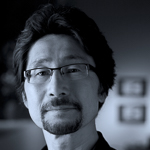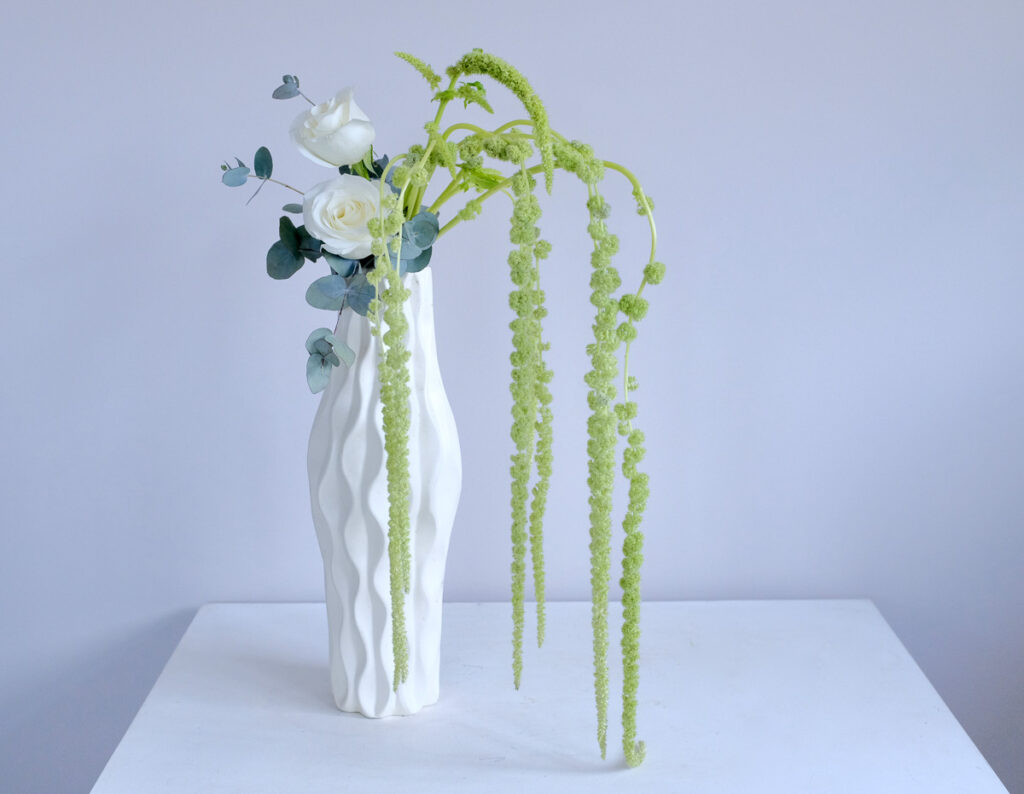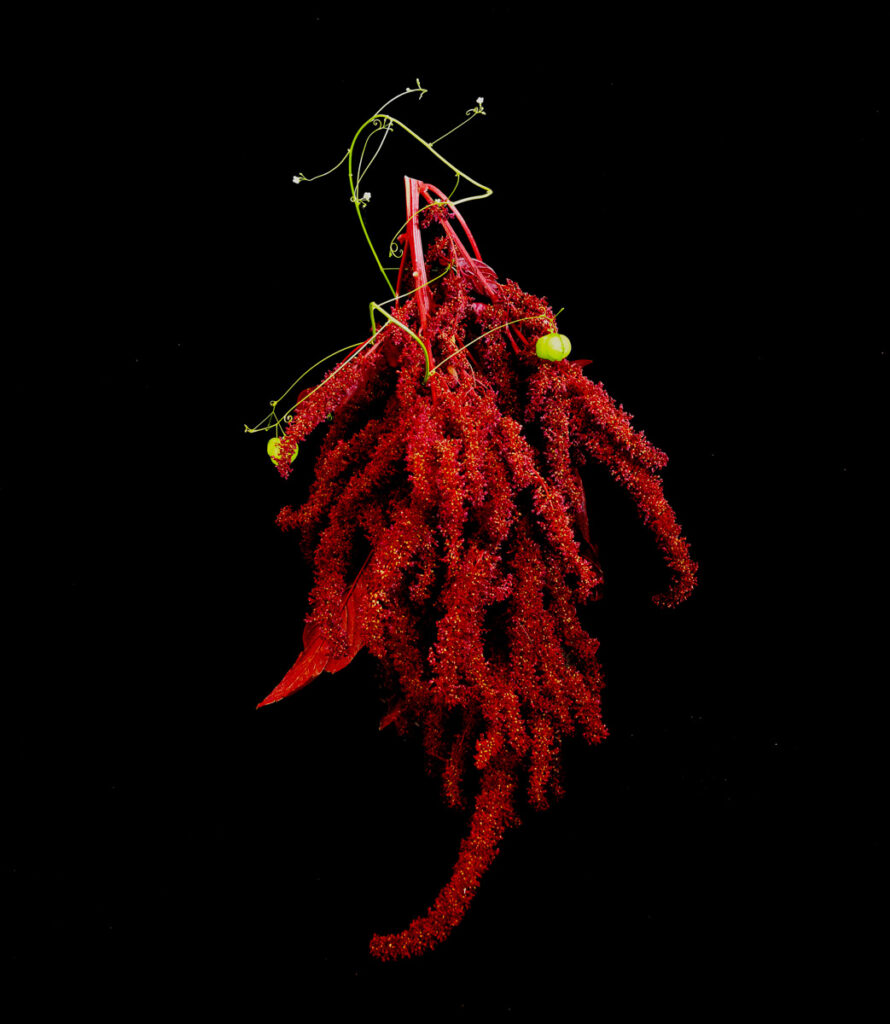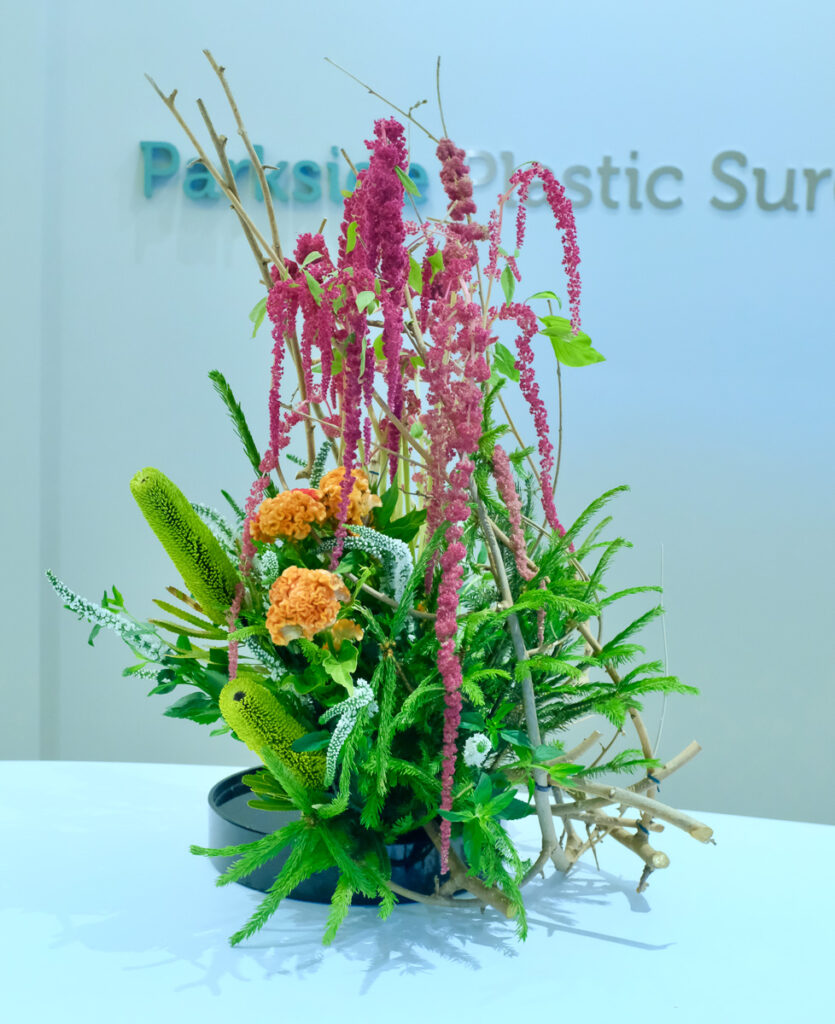For Shoso Shimbo, the meaning of Ikebana goes beyond art and design.
“Teaching Ikebana may be the best job in the world”
I often think so. The students are well motivated. It’s easy to see their progress and best of all they are almost always happy at the end of the class. If there were no financial concerns, teaching ikebana would be the best job for me.
In Australia, however, it is far from being an established or stable occupation. The number of students who would like to learn ikebana is so small. Many people don’t even know what ikebana is. That is one of the reasons why we are promoting ikebana through the Melbourne Ikebana Festival.
Also, there is another aspect that makes teaching ikebana difficult. I noticed lately that a few advanced students are struggling to gain the essence of ikebana. Their works are often not poetic. Poetic ikebana is harmonious in design. It looks lively. We can feel the harmony between nature and artist, rather than an artist’s self-expression or the expression of ego. Poetic ikebana suggests that it is the product of deep meditation.
After talking to some students, I started to realise that there may be something deep that makes ikebana hard to learn at an advanced level especially outside Japan.
There are several myths regarding ikebana today. Probably the biggest myth is that ikebana is art, although ikebana is often translated as “Japanese art of flower arrangement”. This myth may be a cause of making it hard for some ikebana students to learn its essence. If you learn ikebana just as art, focusing on its design principles and design elements —a minor but important aspect of art—you can certainly learn its basics. However, at an advanced level, you need a different kind of training to acquire its essence and make your work poetic. Ikebana has something beyond art and design.
Ikebana has a 500-year history in Japan, but it became “art” only in the 1920s. Under the influence of Western modernism, the Freestyle Ikebana Movement emerged in the 1920s and ’30s. The leaders of the movement attacked the traditional ikebana as not “artistic” and promoted in their new school’s freestyle ikebana in which artists can express individuality without following set patterns. Although their effort to modernise ikebana has been highly evaluated, many traditional aspects of ikebana have remained unchanged.
While the modern new ikebana schools valuing freestyle are dominant in ikebana today, it seems that both modern and traditional aspects of ikebana are valued even among the new ikebana schools in Japan. Outside Japan, however, the focus seems to be on the modern aspect of ikebana, which is actually related to Western modernism. Not enough attention has been paid to the traditional or original aspect of ikebana.
What was ikebana like before it became art? Its social function was historically as an indoor display, but its artistic goal was, according to Ikenobo Senno (1482? – 1543?), the most important ikebana master in the history of ikebana, to express the essence of nature symbolically based on the essence of natural materials. Senno also stated that ikebana is an aid to achieve spiritual enlightenment.
So probably we can say that learning ikebana has two different aspects: learning design (as a part of art) emphasised by modern ikebana and learning personal development emphasised by traditional ikebana. These two types of learning are roughly equivalent to learning at a conscious level and learning at an unconscious level. It is the latter that makes our work poetic.
Learning ikebana is similar to learning Zen meditation. In Zen sometimes Koan questions are used such as ”Two hands clap and there is a sound”. What is the sound of one hand clapping? My interpretation is that thinking about the Koan intellectually at a conscious level helps deepen our meditation at an unconscious level. The Koan is an aid, or a supplement to cultivate unconscious learning, which is the true goal of Zen. The details of the Koan are not so important.
Learning about ikebana elements and principles or some techniques are all like Koan. They are great aids to deepen your meditation and cultivate your creative foundation at an unconscious level.
In essence, learning ikebana means learning meditation. The focus should be on the process rather than the product. Really experiencing meditation in the process of creation is crucial, especially in order for advanced students to develop further and acquire the ability to create poetry in ikebana.
There is no quick fix or special training to master ikebana. Whether you can acquire unconscious learning depends on your will and attitude, not on your artistic talents. You have to decide to spend time acquiring techniques to control your mind so that you can meditate with the right attitude, in silence and solitude.
When I asked about the quickest way to master ikebana, a well-known master simply replied, “practice, practice and practice”. Nothing special. All you need is patience. Time, as well as an intensity of training, is required. Intensity means deep meditation, loving flowers or interacting with the life of flowers.
If I finish my article here, some readers may be disappointed, commenting such as “this article is like a Koan, not mentioning the most important points!”. So I’m going to talk about a few effective learning methods briefly, although I am aware that they may not be so relevant to those who are not practising ikebana.
- Create one work (can be a basic style) spending at least one hour by yourself to make it as perfect as possible. You have to do this in silence. If you feel at the end of the exercise that you spent only 5 minutes or so, that is a good sign. Comments on your work from a teacher would be more meaningful after such an exercise.
- Teach ikebana. Once you obtain a teaching diploma, seek opportunities to teach. You don’t need to wait until you become confident in your meditation (process) and in your work (product).
- Make an ikebana a day. It sounds simple and easy to do. If you decide to do that, however, you will soon find it so hard to continue. It takes a while to learn how to meditate with flowers, and it is a very slow, gradual and sometimes fragile learning process. It is fragile because it is easily disrupted by our negative mental states.
Nevertheless, making an ikebana a day will eventually become an effortless and joyful daily habit. One useful tip is to prepare materials the day before so that you can think about what to make unconsciously overnight.
You will realise at a certain time that you can transform your state of consciousness to that of deep meditation as soon as you touch your flowers. Then you can start to see poetry in your ikebana, and ikebana is finally a part of your life. You may also start to understand the meaning of the way of the flower, and the importance of self-cultivation through meditation.
About Shoso Shimbo
 Shoso Shimbo PhD (shoso.com.au) is a sculptor and a certified teacher of Ikebana. Shoso has won multiple awards including the Gold Award at the Melbourne International Flower & Garden Show and the Arnold Bloch Leiber Prize at the Yering Station Sculpture Exhibition. Shoso has an MA in Japanese Studies, a Master of Fine Art and a PhD in Education. He is also qualified as a garden designer (Japan Horticultural Society) specialising in Japanese gardens. He is a vice president of the International Society of Ikebana Research (ISIR) and a director of Wa: Melbourne Ikebana Festival (ikebanafestival.com), in which he will present a performance with Paul Grabowsky at Melbourne Recital Centre on 11 September 2021. Melbourne Ikebana Festival will also present an Ikebana Container Award for ceramic artists.
Shoso Shimbo PhD (shoso.com.au) is a sculptor and a certified teacher of Ikebana. Shoso has won multiple awards including the Gold Award at the Melbourne International Flower & Garden Show and the Arnold Bloch Leiber Prize at the Yering Station Sculpture Exhibition. Shoso has an MA in Japanese Studies, a Master of Fine Art and a PhD in Education. He is also qualified as a garden designer (Japan Horticultural Society) specialising in Japanese gardens. He is a vice president of the International Society of Ikebana Research (ISIR) and a director of Wa: Melbourne Ikebana Festival (ikebanafestival.com), in which he will present a performance with Paul Grabowsky at Melbourne Recital Centre on 11 September 2021. Melbourne Ikebana Festival will also present an Ikebana Container Award for ceramic artists.





Comments
Thank you for this thoughtful perspective.
Most of us begin our studies because of the feeling, the poetry, that we respond to. Then we have beginners mind and are delighted. As we become more challenged by techniques, and design concepts it’s easy to lose sight of the poetry, and we have to unravel for a while to allow it to surface.
This elusive element is by nature yin, hidden, within, and thus less tangible and subtle. Harder to teach or communicate. The suggestions to practice process and work silently alone are so valuable.
During remote zoom class with my students this past year, it was clear that in this way people experienced a deeper connection to their work. Instead of cameraderie and sharing of materials, they had solitude and the challenge of finding everything. Also time. Their work was to be completed and a photo submitted before class. So more time was spent looking, feeling, resting, adjusting.
Thank you. I’m so refreshed by the articulation of this aspect.
Rachel
Thank you, Rachel for your feedback. Learning Ikebana is just like learning meditation. It is simple, but it seems to be so hard to realise that.
Agreed
40ln94